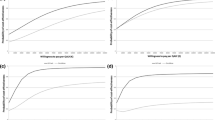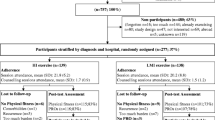Abstract
We undertook a cost-effectiveness analysis (CEA) to compare an exercise and nutritional program with the usual nutritional care concomitant to adjuvant chemotherapy in localized breast cancer patients. The CEA was designed as part of the interventional, controlled, randomized, single-center, open-label PASAPAS study. Breast cancer patients receiving first-line adjuvant chemotherapy at a French Comprehensive Cancer Center were randomized 2:1 to a 6-month exercise program of supervised indoor and outdoor group sessions in addition to usual nutritional care (exercise arm) or a usual nutritional care group receiving dietary and physical activity counseling (control arm). Costs were assessed from the French national insurance perspective (in Euros, 2012). Incremental cost-effectiveness ratios (ICERs) were calculated for four criteria: body mass index, waist circumference, body fat percentage, and estimated aerobic capacity. Uncertainty around the ICERs was captured by a probabilistic analysis using a non-parametric bootstrap method. The analysis was based on 60 patients enrolled between 2011 and 2013. Average intervention costs per participant were €412 in the exercise arm (n = 41) and €117 (n = 19) in the control arm. Total mean costs were €17,344 (standard deviation 9,928) and €20,615 (standard deviation 14,904), respectively, did not differ significantly (p = 0.51). The 6-month exercise program was deemed to be cost-effective compared with usual care for the estimated aerobic capacity. Multicenter randomized studies with long-term costs and outcomes should be done to provide additional evidence. Clinical trial: The PASAPAS study is registered under ClinicalTrials.gov. Trial registration ID: NCT01331772.



Similar content being viewed by others
Abbreviations
- BMI:
-
body mass index
- CEA:
-
cost-effectiveness analysis
- DRG:
-
diagnosis-related group
- ICERs:
-
incremental cost-effectiveness ratios
- HAS:
-
National Authority for Health
- PA:
-
physical activity
References
Bray F, Ferlay J, Soerjomataram I, Siegel RL, Torre LA, Jemal A (2018) Global cancer statistics 2018: GLOBOCAN estimates of incidence and mortality worldwide for 36 cancers in 185 countries. CA Cancer J Clin 68:394–424. https://doi.org/10.3322/caac.21492
OCDE (2018) Screening, survival and mortality for breast cancer. 160–161. https://doi.org/10.1787/health_glance_eur-2018-42-en
Schmitz KH, Speck RM (2010) Risks and benefits of physical activity among breast cancer survivors who have completed treatment. Women's Health (Lond Engl) 6:221–238. https://doi.org/10.2217/whe.10.1
Conn VS, Hafdahl AR, Brown SA, Brown LM (2008)Meta-analysis of patient education interventions to increase physical activity among chronically ill adults. Patient Educ Couns 70:157–172. https://doi.org/10.1016/j.pec.2007.10.004
Cramp F, Byron-Daniel J (2012) Exercise for the management of cancer-related fatigue in adults. Cochrane Database Syst Rev 11:CD006145. https://doi.org/10.1002/14651858.CD006145.pub3
Chlebowski R (2007) Lifestyle change including dietary fat reduction and breast cancer outcome. J Nutr 137:233S–235S
Hartvig P, Aulin J, Hugerth M et al (2006) Fatigue in cancer patients treated with cytotoxic drugs. J Oncol Pharm Pract 12:155–164. https://doi.org/10.1177/1078155206070774
Handbook of Cancer Survivorship | Michael Feuerstein | Springer
Sasso JP, Eves ND, Christensen JF, Koelwyn GJ, Scott J, Jones LW (2015) A framework for prescription in exercise-oncology research. J Cachexia Sarcopenia Muscle 6:115–124. https://doi.org/10.1002/jcsm.12042
Mutrie N, Campbell AM, Whyte F, McConnachie A, Emslie C, Lee L, Kearney N, Walker A, Ritchie D (2007) Benefits of supervised group exercise programme for women being treated for early stage breast cancer: pragmatic randomised controlled trial. BMJ 334:517. https://doi.org/10.1136/bmj.39094.648553.AE
Vardar Yağlı N, Şener G, Arıkan H, Sağlam M, İnal İnce D, Savcı S, Çalık Kutukcu E, Altundağ K, Kaya EB, Kutluk T, Özışık Y (2015) Do yoga and aerobic exercise training have impact on functional capacity, fatigue, peripheral muscle strength, and quality of life in breast cancer survivors? Integr Cancer Ther 14:125–132. https://doi.org/10.1177/1534735414565699
Mishra SI, Scherer RW, Snyder C et al (2012) Exercise interventions on health-related quality of life for people with cancer during active treatment. Cochrane Database Syst Rev:CD008465. https://doi.org/10.1002/14651858.CD008465.pub2
Pierce JP, Stefanick ML, Flatt SW, Natarajan L, Sternfeld B, Madlensky L, al-Delaimy WK, Thomson CA, Kealey S, Hajek R, Parker BA, Newman VA, Caan B, Rock CL (2007) Greater survival after breast cancer in physically active women with high vegetable-fruit intake regardless of obesity. J Clin Oncol Off J Am Soc Clin Oncol 25:2345–2351. https://doi.org/10.1200/JCO.2006.08.6819
Lahart IM, Metsios GS, Nevill AM, Carmichael AR (2015) Physical activity, risk of death and recurrence in breast cancer survivors: a systematic review and meta-analysis of epidemiological studies. Acta Oncol 54:635–654. https://doi.org/10.3109/0284186X.2014.998275
Guillon M, Rochaix L, Dupont J-CK(2018)Cost-effectiveness of interventions based on physical activity in the treatment of chronic conditions: a systematic literature review. Int J Technol Assess Health Care 34:481–497. https://doi.org/10.1017/S0266462318000533
Touillaud M, Foucaut A-M, Berthouze S, Reynes E, Kempf-Lépine AS, Carretier J, Pérol D, Guillemaut S, Chabaud S, Bourne-Branchu V, Perrier L, Trédan O, Fervers B, Bachmann P (2013) Design of a randomised controlled trial of adapted physical activity during adjuvant treatment for localised breast cancer: the PASAPAS feasibility study. BMJ Open 3:e003855. https://doi.org/10.1136/bmjopen-2013-003855
Foucaut A-M, Morelle M, Kempf-Lépine A-S, Baudinet C, Meyrand R, Guillemaut S, Metzger S, Bourne-Branchu V, Grinand E, Chabaud S, Pérol D, Carretier J, Berthouze SE, Reynes E, Perrier L, Rebattu P, Heudel PE, Bachelot T, Bachmann P, Fervers B, Trédan O, Touillaud M (2019) Feasibility of an exercise and nutritional intervention for weight management during adjuvant treatment for localized breast cancer: the PASAPAS randomized controlled trial. Support Care Cancer 27:3449–3461. https://doi.org/10.1007/s00520-019-4658-y
Ministère de la Santé et des Solidarités (2006) Deuxième Programme national nutrition santé, 2006–2010—Actions et mesures. Paris
ENC MCO | Stats ATIH. https://www.scansante.fr/applications/enc-mco. Accessed 19 Mar 2019
Drummond MF, Sculpher MJ, Torrance GW et al (2005) Methods for the economic evaluation of health care programmes, 3rd edn. OUP Oxford, Oxford
Berthouze SE, Minaire PM, Castells J, Busso T, Vico L, Lacour JR (1995) Relationship between mean habitual daily energy expenditure and maximal oxygen uptake. Med Sci Sports Exerc 27:1170–1179
Berthouze SE, Minaire PM, Chatard JC, Boutet C, Castells J, Lacour JR (1993) A new tool for evaluating energy expenditure: the “QAPSE” development and validation. Med Sci Sports Exerc 25:1405–1414
Eschenbach PE of EMT (2010) Engineering economy: applying theory to practice, 3 Har/Cdr. Oxford University Press, USA, New York
Haute Autorité de Santé - Choices in methods for economic evaluation. https://www.has-sante.fr/portail/jcms/r_1499251/en/choices-in-methods-for-economic-evaluation?portal=r_1482172&userLang=en. Accessed 8 Nov 2017
Gridchyna I, Aulois-Griot M, Maurain C, Bégaud B (2012) How innovative are pharmaceutical innovations? The case of medicines financed through add-on payments outside of the French DRG-based hospital payment system. Health Policy 104:69–75. https://doi.org/10.1016/j.healthpol.2011.11.007
Mourgues C, Gerbaud L, Leger S et al (2014) Positive and cost-effectiveness effect of spa therapy on the resumption of occupational and non-occupational activities in women in breast cancer remission: a French multicentre randomised controlled trial. Eur J Oncol Nurs 18:505–511. https://doi.org/10.1016/j.ejon.2014.04.008
van Waart H, van Dongen JM, van Harten WH et al (2018) Cost-utility and cost-effectiveness of physical exercise during adjuvant chemotherapy. Eur J Health Econ 19:893–904. https://doi.org/10.1007/s10198-017-0936-0
Kampshoff CS, van Dongen JM, van Mechelen W, Schep G, Vreugdenhil A, Twisk JWR, Bosmans JE, Brug J, Chinapaw MJM, Buffart LM (2018) Long-term effectiveness and cost-effectiveness of high versus low-to-moderate intensity resistance and endurance exercise interventions among cancer survivors. J Cancer Surviv Res Pract 12:417–429. https://doi.org/10.1007/s11764-018-0681-0
Mewes JC, Steuten LMG, Duijts SFA, Oldenburg HS, van Beurden M, Stuiver MM, Hunter MS, Kieffer JM, van Harten W, Aaronson NK (2015) Cost-effectiveness of cognitive behavioral therapy and physical exercise for alleviating treatment-induced menopausal symptoms in breast cancer patients. J Cancer Surviv 9:126–135. https://doi.org/10.1007/s11764-014-0396-9
May AM, Bosch MJC, Velthuis MJ, van der Wall E, Steins Bisschop CN, Los M, Erdkamp F, Bloemendal HJ, de Roos MA, Verhaar M, ten Bokkel Huinink D, Peeters PH, de Wit GA (2017) Cost-effectiveness analysis of an 18-week exercise programme for patients with breast and colon cancer undergoing adjuvant chemotherapy: the randomised PACT study. BMJ Open 7:e012187. https://doi.org/10.1136/bmjopen-2016-012187
Gordon LG, DiSipio T, Battistutta D, Yates P, Bashford J, Pyke C, Eakin E, Hayes SC (2017) Cost-effectiveness of a pragmatic exercise intervention for women with breast cancer: results from a randomized controlled trial. Psychooncology 26:649–655. https://doi.org/10.1002/pon.4201
van de Wiel HJ, Stuiver MM, May AM et al (2018) (Cost-)effectiveness of an internet-based physical activity support program (with and without physiotherapy counseling) on physical activity levels of breast and prostate cancer survivors: design of the PABLO trial. BMC Cancer 18:1073. https://doi.org/10.1186/s12885-018-4927-z
Briggs AH, O’Brien BJ (2001) The death of cost-minimization analysis? Health Econ 10:179–184. https://doi.org/10.1002/hec.584
Gray AM, Clarke PM, Wolstenholme JL, Wordsworth S (2010) Applied methods of cost-effectiveness analysis in healthcare. Oxford University Press, Oxford
Galvão DA, Newton RU (2005) Review of exercise intervention studies in cancer patients. J Clin Oncol Off J Am Soc Clin Oncol 23:899–909. https://doi.org/10.1200/JCO.2005.06.085
Bourke L, Homer KE, Thaha MA, Steed L, Rosario DJ, Robb KA, Saxton JM, Taylor SJ (2014) Interventions to improve exercise behaviour in sedentary people living with and beyond cancer: a systematic review. Br J Cancer 110:831–841. https://doi.org/10.1038/bjc.2013.750
Short CE, James EL, Girgis A, McElduff P, Plotnikoff RC (2012) Move more for life: the protocol for a randomised efficacy trial of a tailored-print physical activity intervention for post-treatment breast cancer survivors. BMC Cancer 12:172. https://doi.org/10.1186/1471-2407-12-172
Laas E, Vataire A-L, Aballea S, Valentine W, Gligorov J, Chereau E, Rouzier R (2012) Evaluation of the costs and resource use associated with adjuvant chemotherapy for breast cancer in France. J Med Econ 15:1167–1175. https://doi.org/10.3111/13696998.2012.713414
Carayol M, Romieu G, Bleuse J-P, Senesse P, Gourgou-Bourgade S, Sari C, Jacot W, Sancho-Garnier H, Janiszewski C, Launay S, Cousson-Gélie F, Ninot G (2013) Adapted physical activity and diet (APAD) during adjuvant breast cancer therapy: design and implementation of a prospective randomized controlled trial. Contemp Clin Trials 36:531–543. https://doi.org/10.1016/j.cct.2013.09.016
Funding
The authors received funding from the French Institut National du Cancer (2010-228/VO-HO), the Ligue contre le cancer (PME 2010-2011), the Fondation de France (2010-15024), the Association Nationale de la Recherche et de la Technologie (CIFRE/ANRT no. 426/2010) and the Cancéropôle Lyon Auvergne Rhône-Alpes (Programme structurant 2010).
Author information
Authors and Affiliations
Corresponding author
Ethics declarations
Conflict of interest
The authors declare that they have no conflicts of interest.
Ethical approval
This study was approved by the French Ethics Committee (Comité de Protection des Personnes Sud-Est IV, No.11-023), the National Security Agency of Medicines and Health Products that applies for biomedical studies (Agence Nationale de Sécurité du Médicament et des produits de santé, No.B110268-80), and the French National Committee on Informatics and Privacy (Commission Nationale de l’Informatique et des Libertés).
Informed consent
Informed consent was obtained from all individual participants included in the study.
Additional information
Publisher’s note
Springer Nature remains neutral with regard to jurisdictional claims in published maps and institutional affiliations.
Novelty and impact
A cost-effectiveness analysis was designed as part of the interventional, controlled, randomized, single-center, open-label PASAPAS study to compare a 6-month exercise program versus usual nutritional care concomitant to adjuvant chemotherapy in localized breast cancer patients. Incremental cost-effectiveness ratios (ICERs) were calculated for body mass index, waist circumference, body fat percentage, and estimated aerobic capacity. The exercise program was deemed to be cost-effective compared with usual nutritional care for the estimated aerobic capacity.
Appendices
Appendix 1
Appendix 2
Appendix 3
Rights and permissions
About this article
Cite this article
Perrier, L., Foucaut, AM., Morelle, M. et al. Cost-effectiveness of an exercise and nutritional intervention versus usual nutritional care during adjuvant treatment for localized breast cancer: the PASAPAS randomized controlled trial. Support Care Cancer 28, 2829–2842 (2020). https://doi.org/10.1007/s00520-019-05078-4
Received:
Accepted:
Published:
Issue Date:
DOI: https://doi.org/10.1007/s00520-019-05078-4




